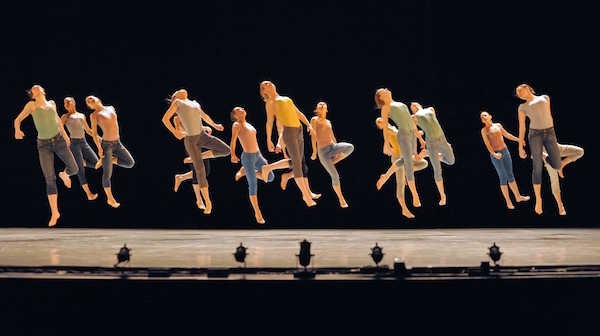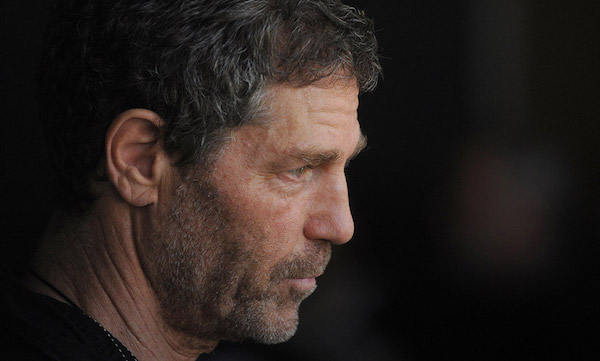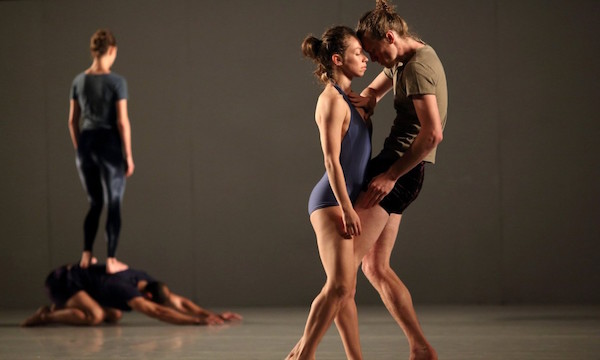Portrait of the Artist as an Iconoclast
Tomer Heymann’s documentary about choreographer Ohad Naharin, Mr. Gaga: A True Story of Love and Dance, begins with a rehearsal scene in which a dancer falls backward repeatedly, as Naharin encourages her to “let go.” This painstaking (and literally painful) process is familiar to most dancers and anyone who’s witnessed the art of making tough choreography look easy. In the case of the iconoclastic Naharin, artistic director of Israel’s Batsheva Dance Company and founder of the Gaga (no relation to Lady) movement technique, the choreography is both incredibly demanding and extremely rewarding, as his dancers and audiences can attest. Mr. Gaga, which delves into Naharin’s creativity as well as his personal life, includes interviews, archival footage and many performance clips. The result is a visually thrilling and soul-satisfying portrait of a remarkable talent and individual.
Born and raised on a kibbutz, Naharin was an instinctive dancer as a child, influenced by his music-loving mother Tzofia. Home movies show bucolic kibbutz life as an idyllic setting for a creative child. Later, Naharin served as an entertainer in the Israeli Army, during which time he first began to create dances. The choreographer, who narrates much of his own story, explains how the “absurd theater” of performing for soldiers influenced dances such Sadeh21. We also learn via an early interview that he began dancing because of a family tragedy, a dramatic story that will be revisited later in the film.
Naharin, whose naturally loose and sinuous body was seemingly built to dance, took classes with the Batsheva company after the army. He came to the admiring attention of Martha Graham, then working with the company, which led to a move to New York City where he was accepted at both Julliard and the American Ballet Theater School, despite his advanced age. Later, he was invited to join Maurice Béjart’s Ballet of the 20th Century. Béjart’s technique, like Graham’s, left him cold and he soon began putting together his own contemporary dances. Around the same time, he fell in love with Mari Kajiwara, a dancer with Alvin Ailey; they married and she joined Naharin’s multicultural troupe.
As the film shows in myriad clips, his highly idiosyncratic choreography is organic, percussive, repetitive and cathartic. Instinctively drawn to feminine movement, Naharin believes that “Dance in its true form is the opposite of macho.” Though the film highlights Naharin’s prodigious talents, it doesn’t shy away from his failings. An often intimidating taskmaster, he yells at his dancers during a performance. “Don’t fuck with me. My life depends on you,” he reminds them before a show. (No pressure!) According to one dancer, crying and screaming occurred on a daily basis and company members often walked out, but they always came back because “the work was worth it.” Naharin also expresses great appreciation for his dancers, who are selected for their ability to bring something of themselves to his work.
Over the years, the demands of dance took a toll on his body. At one point, told he wouldn’t be able to dance— or maybe even walk—again, due to nerve damage, he began developing Gaga, a healing movement language. Natalie Portman attests to the benefits of Gaga and we see all ages and body types move with abandon in a few class clips. (Today, it’s taught at most major dance studios.)
When Naharin returned to Israel to direct Batsheva in 1990, he almost immediately transformed the company’s staid, older audience into a young, hip crowd with energetic dances such as Kyr and Anaphase. He became a sort of cultural hero in 1998 when Batsheva refused to perform at the nation’s 50th anniversary celebration after being pressured to wear more modest costumes. The film becomes poignant when Naharin suffers a great personal loss, though he channels his grief (like everything else) into movement and continues working.
An uplifting film about a man clearly born to move and create, Mr. Gaga is a revealing portrait of a true visionary, as singular and uncompromising as they come.
Mr. Gaga: A True Story of Love and Dance is playing at the Elinor Bunim Monroe Film Center (Lincoln Center) and Film Forum.
—Marina Zogbi




